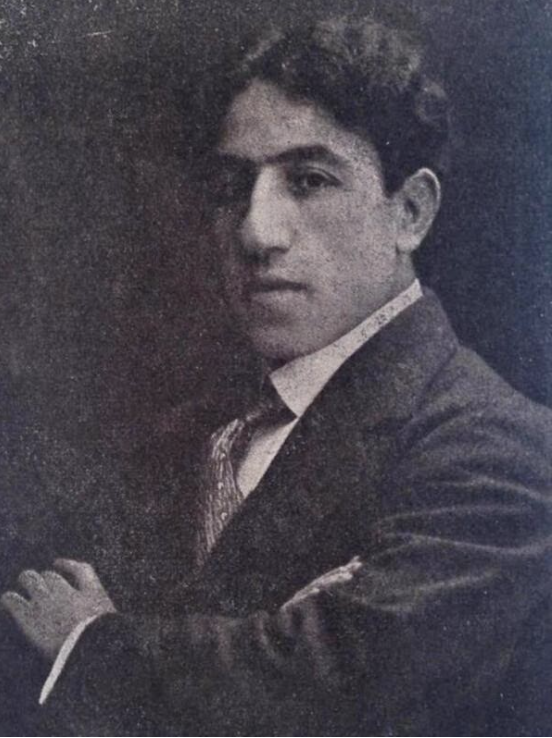A few thoughts on the words բամ and փորոտալ
I was led to think of the above two words in connection with the Church Feast of the Vardanank‘, the Vardanian Saints, which was celebrated only the other week. But rather than plunge headlong into the words themselves, I shall start with a rather fascinating excursus, if I may.
Pietro Bianchini (1828-1905), characterised as «իտալացի կտրիճ երաժիշտ... Պ. Պետրոս Պիանքինի» by an anonymous Armenian writer (“an heroic Italian musician, Mr Peter Bianchini”), was a Venetian violinist, composer, conductor and teacher.
At present he is remembered, if at all, for his harmonised transcription of the chants of the Armenian Divine Liturgy, based on the singing of the Mekhitarist Fathers in San Lazzaro, on which he started working in 1855. Few know that Bianchini may well have been the very first to publish substantial excerpts from the repertory of Armenian sacred chants in Western staff notation. Yet I should now like to mention a completely different piece – one that most Armenians know, albeit without knowing that it was composed by Bianchini!
Generations of diasporan Armenian schoolchildren have learned to sing a celebrated song, without knowing that Bianchini was the composer: namely «Բա՜մ. փորոտան» – a setting of an excerpt from a poem by the Mekhitarist monk, botanist, historian and poet, and almost exact contemporary of Bianchini’s, namely Fr. Łewond Ališan (1820-1901), Երգ ու գնացք զօրացն հայոց ընդ Վահանայ Մամիկոնենոյ ի Շաւարշական դաշտին վրէժք (1850), which he published in San Lazzaro, Venice in 1850. It is the “song and march” of the rallying Armenian soldiers under Vahan Mamikonean, eager to avenge the defeat of Vardan Mamikonean of 451.
As an aside, I might mention that my attention has been drawn to the fact that some rebellious pupils may have had recourse to fitting the song with alternative but similar-sounding satirical words, with a fair peppering of Turkish to boot – but I imagine that readers will not be interested in those (although comments will be welcome)! There were also innumerable, more legitimate musical arrangements made of the song – and so far I have had much fun collating and contrasting seven versions of it, and tracing out certain discernible trends and tendencies.
It would be no exaggeration to say that Bianchini’s setting has made Ališan’s poem famous, and was adopted by the people as a kind of informal national anthem. These two giants were almost exact contemporaries, and almost certainly knew each other well. And only a generation or so later, the song was recorded, twice, by the celebrated tenor singer (a friend and protegé of Komitas, and a soloist at La Scala in Milan and at the Paris Opera), Armenag Shah-Mouradian (1878-1939) – known as the “nightingale of Tarōn”.
I have placed both recordings on my YouTube channel, where they may be enjoyed by all. The first recording was made in Constantinople in 1914, when the singer was accompanied by none other than Archimandrite Komitas himself at the piano. The second recording was made in New York in May 1917, with orchestral accompaniment.
I am grateful to the Cairo-based Armenian musicologist, Haig Avakian, for his generosity in providing me with photographs of both discs. It is notable that in neither case is Bianchini named as the composer; and the later recording merely mentions it as a “National song”. Though misleading, this does indicate the status this piece had come to enjoy by now. No less interestingly, readers will notice that in both instances the song was mis-labelled as Բամբ որոտան (instead of the correct Բամ փորոտան), and indeed in the earlier recording it is clearly discernible that Shah-Mouradian even sings “Pamp vorodan” instead of “Pam porodan”!
But what exactly does «Բա՜մ. փորոտան» mean, and why was there a tendency to mis-transcribe those two words? Բամ is a somewhat onomatopoeic ձայնարկութիւն– an interjection or an exclamation. A good equivalent might be “Boom!”. But the problem arises with the second word. The verb փորոտալis relatively unknown, and therefore many have incorrectly assumed that the proper title is in fact Բամբորոտան – presumably loosely meaning “Deep[ly] they thunder!” – բամբ being Komitas’ favourite choice of Armenian word for “bass” – the lowest male singing voice. But in fact, there truly does exist a verb փորոտալ, and it means “to roar, to blow” – with a definite suggestion that the sound is deep and mighty – rather as the roar of a lion. The word փորis relevant here: it means belly (or abdomen – the usual Armenian equivalent for the more scientific word being որովայն). One thinks of advice given to singers and brass players – the best of whom always seem to produce the breath from the diaphragm, producing a fuller and more rounded sound and better control. Less agreeably, our verb is also related to the word փորոտիք, which many will know from various Armenian translations of Scripture: in the Acts of the Apostles (1:18) we read that Judas, having betrayed his master, died and his entrails – փորոտիք – fell out. So much, then, for the etymology of փորոտալ. All in all, we may safely conclude that «Բա՜մ. փորոտան» means something along the lines of“ ‘Boom!’ they roar”. Admittedly it does not seem to have quite the same glorious ring to it in English as it does in the Armenian original! But I hope you might now enjoy the song, knowing what it was genuinely called, and what it is about!


